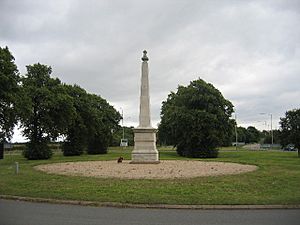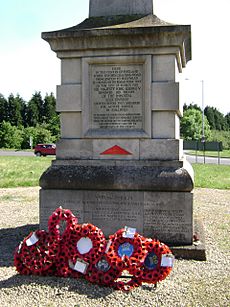29th Division War Memorial facts for kids

The 29th Division War Memorial is a special monument that remembers the brave soldiers of the British 29th Division. They served during the First World War. You can find this memorial near Stretton-on-Dunsmore, close to Rugby, Warwickshire. It stands where the A45 and B4455 roads meet.
This memorial is very important. In 1987, it became a Grade II listed building, meaning it's a historically important structure. Its status was even upgraded to Grade II* in 2015. Historic England says it's "probably the most significant single memorial in Britain" connected to the Gallipoli campaign.
What Was the 29th Division?
How the 29th Division Was Formed
The 29th Division was put together in the East Midlands starting in late 1914. Most of its soldiers were regular army members. They had returned from their duties guarding different parts of the British Empire.
King George V Reviews the Troops
About 18,000 soldiers gathered near Rugby on March 12, 1915. They formed a long marching line, about 2 miles (3.2 km) long. King George V came to review them. The column took over an hour to march past the King, who watched from his horse, Delhi.
Where Did the 29th Division Fight?
Soon after the review, the 29th Division left England to fight in the war. They joined other forces, including the Royal Naval Division, the Australian and New Zealand Army Corps (ANZACs), and French troops. Together, they formed the Mediterranean Expeditionary Force. This force landed on the Gallipoli peninsula in April 1915.
The British forces left Gallipoli in January 1916. The 29th Division then moved to France. They fought on the Western Front. This included the very first day of the Battle of the Somme. They also fought in the Battle of Arras and the Third Battle of Ypres (also known as Passchendaele).
After the war ended with the Armistice, the division became part of the British Army of the Rhine. They helped occupy parts of Germany. By the time the division was officially ended in March 1919, about 94,000 of its soldiers had been injured or killed.
About the 29th Division Memorial
Who Designed and Built the Memorial?
The memorial was designed and built by a company called Robert Bridgeman and Sons from Lichfield. It is a tall, tapering stone pillar, about 12 meters (39 feet) high. On top of the pillar is a stone urn with a crown and an orb. The pillar stands on a square base.
What Does the Memorial Say?
The north side of the memorial's base shows the red triangle symbol of the 29th Division. Below this is a panel with an inscription. It says:
"HERE / IN THE CENTRE OF ENGLAND / WHERE TELFORD'S COACHING-ROAD / FROM LONDON TO HOLYHEAD / IS CROSSED BY THE ROMAN FOSSE WAY / ON THE 12TH OF MARCH 1915 / HIS MAJESTY KING GEORGE V / REVIEWED HIS TROOPS / OF THE IMMORTAL / XXIX DIVISION / SHORTLY BEFORE THEY EMBARKED / FOR ACTIVE SERVICE / IN GALLIPOLI"
It also mentions that the monument was put up by people from the county. The base also lists the different units that made up the division.
How Was the Memorial Funded?
The memorial was built after the war. It is located near the spot where the 29th Division was reviewed in 1915. The cost was £646, which was raised by public donations. An additional £720 was given by John Montagu Douglas Scott, 7th Duke of Buccleuch, who also donated the land for the memorial.
When Was the Memorial Unveiled?
The memorial was officially revealed on May 24, 1921. This day was known as Empire Day. Over 7,000 people attended the ceremony. William Craven, 4th Earl of Craven, who was the Lord Lieutenant of Warwickshire, unveiled it. Lord Algernon Percy, Chairman of Warwickshire County Council, accepted it. The Bishop of Coventry, Huyshe Yeatman-Biggs, dedicated it.
What Surrounds the Memorial?
The memorial stands in a circle of gravel. It is surrounded by an avenue of lime trees. These lime trees were planted in the 1950s and later replaced. They took the place of older elm trees that lined the London Road (now the A45). These elm trees were originally planted in the early 1700s across Dunsmore Heath. Many of them were blown down in a storm in 1912.
Two captured field guns used to be displayed next to the memorial. However, it is thought that they were taken away for scrap metal during the Second World War.
Today, the memorial is in the middle of a roundabout. This roundabout was built in the mid-1980s. It is at the junction of the A45 (which is close to the A5 route, following the Roman Watling Street) and the B4455 (part of the Roman Fosse Way). The memorial was listed as a Grade II building in 1987 and upgraded to Grade II* in March 2015.



